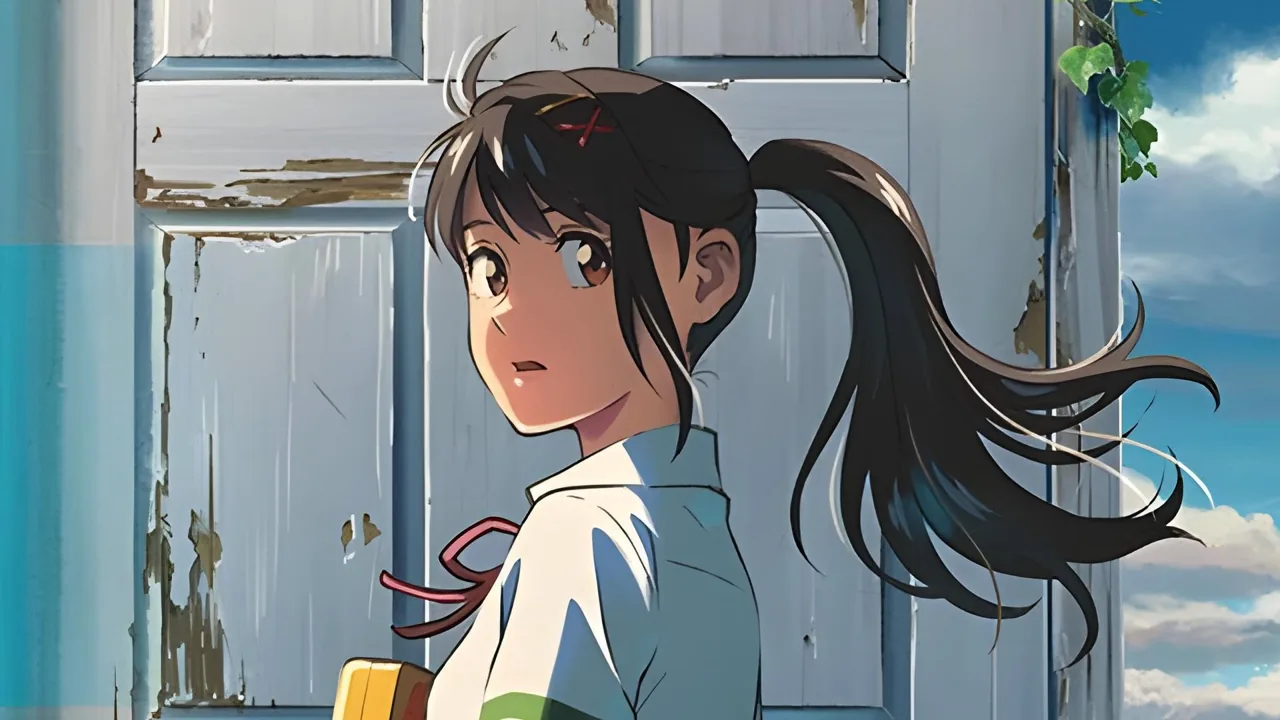Blogs
“Suzume” Review
Writer-director Makoto Shinkai has become a well-known name in mainstream anime discussions since his 2016 hit Your Name made anime history with its impressive run of critical and commercial success. His distinct aesthetic and voice result in films that balance reality and fantasy with breathtaking beauty and heartfelt sincerity. Suzume is no exception: a delightful, vibrant visual masterpiece that embraces the difficult feelings of loss and longing. To put it mildly, Shinkai’s latest soulful creation will break your heart.
When Suzume Iwato (Nanoka Hara) is led to an abandoned resort in the mountains of her quiet town of Kyushu in Southwestern Japan by a mysterious traveler, she discovers a strange doorway that offers a glimpse into an eerily familiar, magical world. She is forced to join forces with the traveler Souta (Hokuto Matsumura), a handsome young man who moonlights as a door “Closer” per family tradition, to prevent the inhabitants of this other realm from entering and wreaking havoc. Suzume discovers that there are dozens of these doors scattered throughout Japan’s many abandoned locations, and that the world behind them, the Ever After, is home to a powerful dark force – a massive worm-like creature made up of swirling red tendrils – held in place by only two “keystones.”
Suzume unknowingly releases one of these keystones, causing it to manifest as a mischievous god-like white kitten named Daijin (Ann Yamane). Daijin curses his soul to enter a three-legged chair – a well-loved keepsake from Suzume’s mother who went missing many years ago – before Souta can turn it back to stone and restrain the worm creature. Suzume and Chair-Souta must travel across Japan to find and capture the keystone cat in order to prevent the worm creature from bursting through any of the countless doors and slamming its massive worm body down on the planet with enough force to blow it to smithereens.
The setting of Suzume, which is plagued by natural disasters and the passage of time, is immediately reminiscent of Makoto Shinkai’s earlier works. A calm contrast to the film’s sillier scenes is suggested by a young Suzume going around by herself and looking for her mother in a town reduced to wet rubble and ruins. This makes it obvious that Suzume has an eye for the dark and melancholy in addition to the gleaming gloss of its color pallet.
Suzume frequently uses the motif of earthquakes. The ground shakes and earthquake notifications start to ping on everyone’s phones every time the worm creature tries to enter one of the doors. In these instances, Shinkai steps back from the main protagonists to reveal the larger context of the narrative: a Japan still suffering from the effects of its recent earthquakes. New supporting characters are introduced at each stage, giving the setting more life and background while raising the stakes for Suzume’s quest. Although Shinkai never minimizes the gravity of these natural calamities among his characters, the fact of approaching earthquakes being so pervasive in Suzume may in some respects feel worse to non-Japanese audiences than it does to individuals who live close to historically active faults.
Up until Suzume’s past is revealed, the plot is increasingly overshadowed by the possibility of a catastrophic earthquake. The tragic revelation has connections to the actual 3/11 Tohoku disaster, an earthquake and tsunami that resulted in thousands of deaths, countless displacements, and the meltdown of the Fukushima Daiichi nuclear plant. This addendum to the story connects the many components of the tale together by fostering a common sense of suffering and loss.
The movie repeatedly travels to Japan’s many abandoned locations, such as landslide-devastated schools and underfunded amusement parks, representing an emotional history with living people who are now dead and echoing the kind of painful, melancholy nostalgia that results from witnessing everyday life uprooted and destroyed. Suzume and Souta are tasked with averting this identical existential catastrophe by stopping the worm, albeit on a larger, worldwide scale. Despite sentiments of pessimism in the face of loss, our future is defined by our connections to the past and people around us.
Suzume stands out a little bit as a coming-of-age story that looks much more focused in its concepts and other character connections, despite the fact that Makoto Shinkai’s works are known for primarily featuring love issues. For instance, along with her mother, Suzume’s aunt Tamaki (Eri Fukatsu) serves as one of the film’s primary emotional foundations. Sadly, while additional familial relationships are being explored, the typical love interest lacks true depth. The past of Souta is sufficiently developed to leave few unanswered questions, but it doesn’t seem to be sufficient to truly ground his character and connect the audience’s hearts to his terrible situation of being trapped in the shape of a chair and steadily losing sentience.
In some ways, it appears that in early drafts, Shinkai nearly completely abandoned the skeletal remains of a relationship, retaining only a few traces of romantic feelings in addition to corny lines of Suzume’s devotion. Although Suzume is just halfway through her high school education, Souta is at least a few years older and almost through with university, which makes for a less-than-savory romantic foundation. Strengthening their bond would create a more realistic link between the two and help better explain some of the choices Suzume takes in the latter half of the movie if the age difference wasn’t an issue.
It’s difficult to discuss Makoto Shinkai’s films without mentioning his distinctive style and tone. It would be simple to distinguish between the two, saying that his tone is the result of falling under the amazing realism genre while his images have a straightforward style and flair. Suzume, however, unmistakably makes the argument for a shared silence experience. In an effort to convey the kind of beauty that makes you stop in your tracks and reflect on what you are experiencing, Shinkai’s painterly landscapes and hyper-detailed frames are tailored to emulate a breath hold rather than using flashy images to amp up the energy. Working once more with Your Name’s Takumi Tanji as art director, Shinkai’s paintings are as striking as ever—a daring and creative representation of a damaged world filled with love and care.
The music from the rock group RADWIMPS, who collaborated with them previously on the albums Your Name and Weathering with You, also supports this style and tone. Similar to their previous collaborations with the writer-director, their songs in Suzume effortlessly capture the pervasive feelings of dream-like longing and quiet gravitas in Makoto Shinkai’s movie. However, with the addition of co-composer Jazuma Jinnouchi, the songs also acquire some new epic flavor (Star Wars Visions: The Ninth Jedi).
Suzume, which depicts natural calamities, also manages to strike a good mix between comedy and drama, which is crucial considering that the movie also has a walking, talking chair, a cunning cat god, and world-ending phallic worms. Its varying tonal structure is almost reminiscent of Your Name, which took a ridiculous idea and gradually transformed it into something much more significant by simply dealing with it without irony. Although the characters in Suzume may not be the most fully developed, Shinkai’s characters have conviction, and that will more than suffice to win you over.
One of Makoto Shinkai’s most gratifying pieces to date is Suzume. Suzume may share certain similarities with the writer-most director’s recent blockbusters, but its earnestness and exceptional art direction set it apart in a Hollywood-dominated field of camp and sarcasm. Most significantly, Suzume, immortalized in the motion picture, will always serve as a reminder of Japan’s past and the emotions that endure in the wake of tragedy. Without firsthand knowledge, it’s nearly impossible to say whether the movie handles the 3/11 tragedy skillfully and appropriately, but its inclusion in the story will undoubtedly be a useful talking point when it comes to educating young audiences about the ongoing trauma that exists in Japan and throughout the rest of the world.
As a result, Makoto Shinkai’s Suzume further demonstrates the value of animation in the greater cinematic scene. If there is any justice in the world, Suzume will be seen by a sizable audience in theaters all over the world.
Suzume hits theaters April 14!
>>>> READ MORE: Review of the ‘Succession’ Season 4 Premiere: The Last Countdown

